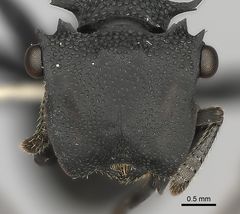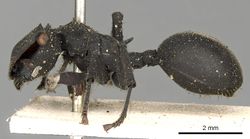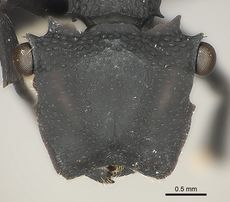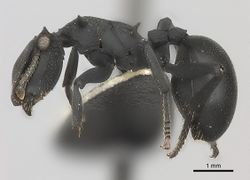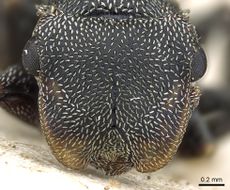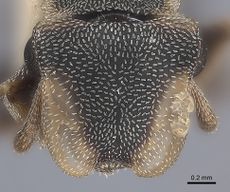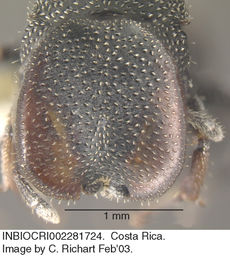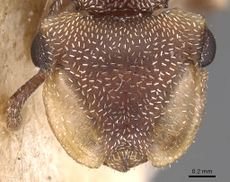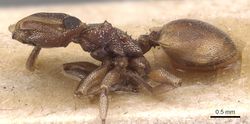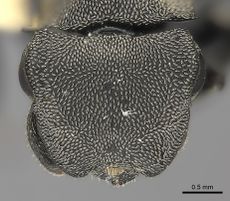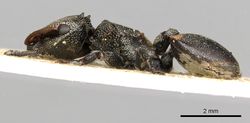Key to Cephalotes Species
The following key to Cephalotes workers is based on de Andrade, M. L. & Baroni Urbani, C. 1999. Diversity and adaptation in the ant genus Cephalotes, past and present. Stuttgarter Beitrage zur Naturkunde Series B (Geolgie and Palaontologie). 271:1-889.
The workers of Cephalotes klugi and Cephalotes prodigiosus are not included in the key since they are still unknown. The remaining species can be identified by means of the following key.
1
- Vertexal angles bispinose . . . . . 2
- Vertexal angles differently shaped but never with spines . . . . . 8
2
return to couplet #1
- Eyes below the antennal scrobes. Vertex without denticles . . . . . 3
- Eyes behind the antennal scrobes. Vertex with a small pair of denticles . . . . . 6
3
return to couplet #2
- Mid and hind basitarsi abruptly narrowing distally in lateral view. Frontal carinae strongly crenulate. Body opaque. Brazil, Peru . . . . . Cephalotes serraticeps
- Mid and hind basitarsi not strongly narrowing distally . . . . . 4
4
return to couplet #3
- CI ≤ 122. Frontal carinae not covering completely the genae. Costa Rica, Panama . . . . . Cephalotes alfaroi
 Head of Cephalotes alfaroi worker |
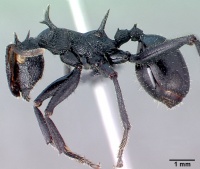 Lateral view of Cephalotes alfaroi worker |
- CI ≥ 127. Frontal carinae covering completely the genae . . . . . Cephalotes atratus
 Head of Cephalotes atratus worker |
 Lateral view of Cephalotes atratus worker |
6
return to couplet #2
- Propodeal spines much longer than the basal face of the propodeum. Colombia, Guyana, Brazil, Peru . . . . . Cephalotes placidus
- Propodeal spines never as long as the basal face of the propodeum . . . . . 7
7
return to couplet #6
- CI ≥ 128. PI ≤ 100. Dorsum of the propodeum passing into the lateral faces with a marked ridge. Brazil . . . . . Cephalotes oculatus
- CI < 126. PI ≥ 104. Transition between the dorsal and lateral faces of the propodeum simply round. Colombia, Venezuela, Guyanas, Brazil, Ecuador, Peru, Bolivia . . . . . Cephalotes opacus
8
return to couplet #1
- Dorsum of the head with long erect hairs . . . . . 9
- Dorsum of the head with erect hairs either missing or very short . . . . . 25
9
return to couplet #8
- Basal and declivous faces of the propodeum forming an angle of 90° and separated by a pair of spines. Pronotum with a pair of lateral spines . . . . . 10
- Propodeum without distinct basal and declivous faces, i.e., inclined, or, if angulate, the two faces never separate by a pair of spines. Pronotum, laterally, at most denticulate, but never with spines . . . . . 17
10
return to couplet #9
- Gaster concolour with the body . . . . . 11
- Gaster coloured differently than the rest of the body . . . . . 14
11
return to couplet #10
- Posterior fourth of the head dorsum with sparse, thin hairs. Gaster covered with thick, appressed pilosity. Dominican Republic . . . . . Cephalotes argentiventris
- Posterior fourth of the head dorsum with curved, thick hairs. Gaster pilosity thinner and much sparser . . . . . 12
12
return to couplet #11
- Basal face of the propodeum densely covered by appressed, canaliculate hairs hiding the sculpture. Dominican Republic . . . . . Cephalotes auricomus
 Head of Cephalotes auricomus worker |
 Lateral view of Cephalotes auricomus worker |
- Basal face of the propodeum with sparse, appressed canaliculate hairs not hiding the sculpture . . . . . 13
13
return to couplet #13
- Rugosities of the first gastral tergite confined to the articulation area with the postpetiole, otherwise smooth. Dominican Republic: described from COPAL . . . . . Cephalotes resinae
- First gastral tergite longitudinally rugose over its entire anterior fourth. At most the gastral lobes can be smooth in some specimens. Dominican Republic, Haiti . . . . . Cephalotes hamulus
 Head of Cephalotes hamulus worker |
 Lateral view of Cephalotes hamulus worker |
14
return to couplet #10
- First gastral tergite orange with a black spot in the middle. Dominican Republic, Haiti . . . . . Cephalotes unimaculatus
 Head of Cephalotes unimaculatus worker |
 Lateral view of Cephalotes unimaculatus worker |
- First gastral tergite orange or reddish-brown but without median spot . . . . . 15
15
return to couplet #14
- Gaster red. PPeI < 224. Haiti . . . . . Cephalotes vinosus
 Head of Cephalotes vinosus worker |
 Lateral view of Cephalotes vinosus worker |
- Gaster orange or brown. PPeI > 235 . . . . . 16
16
return to couplet #15
- Propodeum almost destitute of pilosity. Gaster orange. Dominican Republic . . . . . Cephalotes flavigaster
 Head of Cephalotes flavigaster worker |
 Lateral view of Cephalotes flavigaster worker |
- Propodeum densely hairy; the pilosity covering the sculpture. Gaster light brown. Dominican Republic: described from COPAL . . . . . Cephalotes taino
17
return to couplet #9
- First gastral tergite anterolaterally simple, without lobes or expansions . . . . . 18
- First gastral tergite, anteriorly, bearing a pair of thick lobes or lamella-like expansions . . . . . 22
18
return to couplet #17
- First gastral tergite with the lateral and posterior borders transparent-yellowish, always much lighter than the rest of the tergite . . . . . 19
- First gastral tergite with the lateral and posterior borders concolorous with the rest of the tergite . . . . . 20
19
return to couplet #18
- First gastral tergite bearing, in addition to sub erect hairs, a dense covering of long, appressed hairs. Mexico . . . . . Cephalotes hirsutus
- Appressed hairs of the first gastral tergite very sparse. Mexico . . . . . Cephalotes insularis
20
return to couplet #18
- Ventral face of the head with irregular, longitudinal rugosities. Arizona and North Mexico . . . . . Cephalotes rohweri
 Head of Cephalotes rohweri worker |
 Lateral view of Cephalotes rohweri worker |
- Ventral face of the head with regular, longitudinal rugosities . . . . . 21
21
return to couplet #20
- Mesonotum with regular longitudinal rugosities; body superficially shining. Mexico . . . . . Cephalotes wheeleri
- Mesonotum with irregular longitudinal rugosities, body opaque. Mexico . . . . . Cephalotes toltecus
22
return to couplet #17
- First gastral tergite anterolaterally with lamellaceous semi-transparent expansions . . . . . 23
- First gastral tergite anterolaterally with solid lobes . . . . . 24
23
return to couplet #22
- First gastral tergite with dense, thick, appressed hairs missing only on a pair of longitudinal, posterior stripes. Longitudinal rugulation of the mesosoma superficial. Mexico . . . . . Cephalotes auriger
- First gastral tergite with sparse, thick, appressed hairs on the whole surface. Longitudinal rugulation of the mesosoma deeply impressed. Mexico . . . . . Cephalotes chacmul
24
return to couplet #22
- Erect, truncate hairs sparse (< 50 on the first gastral tergite). Body foveae superficial. Brazil, Paraguay . . . . . Cephalotes guayaki
 Head of Cephalotes guayaki worker |
 Lateral view of Cephalotes guayaki worker |
- Erect, truncate hairs dense (> 100 on the first gastral tergite). Body foveae impressed. Brazil, Argentina, Paraguay . . . . . Cephalotes fiebrigi
 Head of Cephalotes fiebrigi queen |
 Lateral view of Cephalotes fiebrigi queen |
25
return to couplet #8
- Head and mesosoma strongly convex, the convexity very evident also in dorsal view (Fig. 310). Argentina . . . . . Cephalotes quadratus . . . . . also see the newly described (2014) Cephalotes specularis
 Head of Cephalotes quadratus worker |
 Lateral view of Cephalotes quadratus worker |
- Head and mesosoma only gently convex or flat . . . . . 26
26
return to couplet #25
- Body covered with long, pointed, flexuous hairs . . . . . 27
- Body covering with hairs of different types, but never long, pointed and flexuous. A few pointed hairs may be present on the external border of the frontal carinae and on the sides of the meso- and metasoma, of the petiole, of the postpetiole and on the gaster . . . . . 31
27
return to couplet #26
- Petiole and postpetiole without lateral spines . . . . . 28
- Petiole and postpetiole with pronounced lateral spines . . . . . 29
28
return to couplet #27
- HBaI < 35. Pronotum, laterally, with a pair of projecting, angular expansions. Dominican amber: FOSSIL species . . . . . Cephalotes jansei
- HBaI ≥ 40. Pronotal lateral expansions much more narrow and obtuse. Dominican amber: FOSSIL species . . . . . Cephalotes serratus
29
return to couplet #27
- Pilosity dense over entire body. Gaster opaque. Cephalic foveae dense and small, i. e. each fovea ~ 1/5 the maximum eye length. Brazil and Paraguay . . . . . Cephalotes pilosus
- Body pilosity sparser. Gaster superficially or completely shining. Cephalic foveae sparse and larger, i. e. each fovea ~ 1/4 the maximum eye length . . . . . 30
30
return to couplet #29
- Gaster completely shining. Eyes never more than 1/4 of the median head length (mandibles excluded). Argentina . . . . . Cephalotes liogaster
- Gaster sub opaque. Eyes more than 1/4 of the median head length (mandibles excluded). Argentina . . . . . Cephalotes lanuginosus
 Head of Cephalotes lanuginosus worker |
 Lateral view of Cephalotes lanuginosus worker |
31
return to couplet #26
- First gastral tergite with massive anterior lobes concolorous with the rest of the gaster. Body colour reddish brown, dark brown or black. Hind Femora never angulate . . . . . 32
- First gastral tergite without expansions, or with anterior lamellaceous or membranaceous expansions paler than the rest of the gaster. If semimembranaceous lobes are present (incertus) then, colour ferruginous or yellowish brown and hind femora angulate . . . . . 37
32
return to couplet #31
- Sides of the frontal carinae bearing a row of long, pointed hairs. Argentina . . . . . Cephalotes supercilii
- Sides of the frontal carinae with clavate or short, subtruncate hairs, but never with long, pointed hairs . . . . . 33
33
return to couplet #32
- Sides of the frontal carinae, dorsum of the mesosoma, of the pedicel and posterior part of the first gastral tergite with erect, short, sub truncate hairs. Argentina . . . . . Cephalotes fossithorax
- Sides of the frontal carinae with sub clavate or clavate hairs. Dorsum of the mesosoma and of the pedicel never with erect, short, sub truncate hairs . . . . . 34
34
return to couplet #33
- Frontal carinae strongly upturned over and behind the eyes, with a clearly upraised external border. Brazil, Argentina . . . . . Cephalotes bruchi
 Head of Cephalotes bruchi worker |
 Lateral view of Cephalotes bruchi worker |
- Frontal carinae never upturned above the eyes, only weakly differentiate from the cephalic convexity . . . . . 35
35
return to couplet #34
- Head, mesosoma, pedicel, gaster and legs only very superficially foveolate; the foveae almost indistinguishable on the first gastral tergite. (Fig. 291). HBal ≥ 30. Argentina and Paraguay . . . . . Cephalotes bohlsi
- At least head and mesosoma with deep foveae; foveae of the first gastral tergite always well visible (Figs. 292, 318). HBal ≤ 27 . . . . . 36
36
return to couplet #35
- First gastral sternite shining, the reticulation very superficial. Head, mesosoma and pedicel with impressed sculpture. Foveae on the head and mesosoma dense and deep (Fig. 318). Argentina . . . . . Cephalotes bivestitus
- First gastral sternite reticulate and opaque. Head, mesosoma, pedicel and gaster with less impressed sculpture. Foveae on the head and mesosoma sparse and shallow (Fig. 292). Brazil, Argentina, Paraguay . . . . . Cephalotes jheringi
 Head of Cephalotes jheringi worker |
 Lateral view of Cephalotes jheringi worker |
37
return to couplet #31
- First gastral tergite completely surrounded by a membranaceous or lamellaceous border . . . . . 38
- First gastral tergite without expansions or, if a membranaceous or lamellaceous border is present, it never extends to the whole gaster . . . . . 41
38
return to couplet #37
- Pronotum, laterally, with a pair of broad lamellaceous expansions fused with a spine visible in transparency. Body foveae absent to superficial; hairs simple to broad . . . . . 39
- Pronotum, laterally, with a pair of continuous lamellae not fused with a spine. Body foveae deep, the foveae bearing palm leaf-shaped hairs (Fig. 389). Panama, Peru, Colombia, Bolivia . . . . . Cephalotes foliaceus
39
return to couplet #38
- Body shining. Colour yellow. Trinidad & Tobago, from Colombia to Argentina and Paraguay . . . . . Cephalotes clypeatus
 Head of Cephalotes clypeatus worker |
 Lateral view of Cephalotes clypeatus worker |
- Body opaque. Colour darker '. . . . . 40
40
return to couplet #39
- Colour light brown. Membranaceous expansions of the body semitransparent. Brazil . . . . . Cephalotes membranaceus
- Colour dark brown to black. Membranaceous expansions of the body whitish. Brazil . . . . . Cephalotes ustus
41
return to couplet #37
- Frontal carinae with a deep incision over the eyes . . . . . 42
- Frontal carinae straight, not incised, over the eyes . . . . . 51
42
return to couplet #41
- Propodeum with a pair of lateral teeth or denticles. Lateral expansions of the petiole truncate and shorter than the maximum length of the petiole. Florida, Bahamas, Cuba, Dominican Republic . . . . . Cephalotes varians
 Head of Cephalotes varians worker |
 Lateral view of Cephalotes varians worker |
- Propodeum differently shaped, either without denticles or with two or three pairs of denticles. Lateral expansions of the petiole spiniform and as long as or longer than the maximum length of the petiole . . . . . 43
43
return to couplet #42
- HBal (Hind Basitarsal Index) ≤ 35 . . . . . 44
- HBal (Hind Basitarsal lndex > 38 . . . . . 45
44
return to couplet #43
- Propodeum, laterally, with two or three pairs of denticles. PPeI < 138 . PPpl < 149. Mexico to Ecuador . . . . . Cephalotes porrasi
- Propodeum, laterally, without denticles. PPel > 155. PPpl > 173. Jamaica . . . . . Cephalotes jamaicensis
45
return to couplet #43
- Propodeal sides, posteriorly, with one or two pairs of incisions. Mexico to Brazil . . . . . Cephalotes pallens
- Propodeal sides without incisions . . . . . 46
46
return to couplet #45
- Head, mesosoma, pedicel and gaster deeply sculptured; the foveae with thick border, irregular, contiguous and deep (Figs. 215, 218); first gastral tergite with well recognisable sculpture over its whole surface . . . . . 47
- Head, mesosoma, pedicel and gaster with more superficial sculpture; the foveae with thin border, regular, with narrow interspaces and shallow; the first gastral tergite with very reduced sculpture, nearly smooth on the center . . . . . 48
47
return to couplet #46
- Border of the frontal carinae strongly crenulate, with several standing, clavate hairs (Fig. 218). Ventral face of the head simply reticulate. Guyana, Surinam, Brazil and Bolivia . . . . . Cephalotes pallidus
- Border of the frontal carinae weakly crenulate, only with few clavate hairs (Fig. 215). Ventral face of the head reticulate and with superimposed irregular, longitudinal rugosities. Brazil . . . . . Cephalotes patellaris
48
return to couplet #46
- HBaI (Hind Basitarsal Index) < 43 . . . . . 49
- HBaI (Hind Basitarsal Index) ≥ 50 . . . . . 50
49
return to couplet #48
- Body superficially shining. Lobes of the first gastral tergite not strongly protruding anteriorly, their maximum length much shorter than their width. Haiti, Dominican Republic . . . . . Cephalotes decoloratus
 Head of Cephalotes decoloratus worker |
 Lateral view of Cephalotes decoloratus worker |
- Body opaque. Lobes of the first gastral tergite strongly protruding anteriorly, their maximum length subequal to the maximum width. Colombia, Venezuela . . . . . Cephalotes decolor
50
return to couplet #48
- Anterior border of the frontal carinae with three or four pairs of clubbed hairs. Venezuela, Trinidad, Guyana, Brazil, Bolivia . . . . . Cephalotes pallidoides
 Head of Cephalotes pallidoides worker |
 Lateral view of Cephalotes pallidoides worker |
- Anterior border of the frontal carinae without or at most with one pair of clubbed hairs. Brazil, Bolivia and Paraguay . . . . . Cephalotes pellans
 Head of Cephalotes pellans queen |
 Lateral view of Cephalotes pellans queen |
51
return to couplet #41
- Antennal club consisting of the last two antennomeres . . . . . 52
- Antennal club consisting of the last three antennomeres . . . . . 70
52
return to couplet #51
- Sides of the pronotum generally without denticles and broadly expanded. If the pronotal expansions are weakly denticulate (kukulcan, scutulatus, incertus, caribicus) and narrow (incertus, caribicus, kukulcan), the hind femora are angulate . . . . . 53
- Sides of the pronotum with a narrow, denticulate lamella. If the pronotum is only weakly denticulate (bimaculatus), the hind femora are not angulate . . . . . 66
53
return to couplet #52
- Hind femora with a longitudinal crest . . . . . 54
- Hind femora without a longitudinal crest . . . . . 58
54
return to couplet #53
- Fore femora with ventral crest. Mexican amber: FOSSIL species . . . . . Cephalotes maya
- Fore femora without ventral crest . . . . . 55
55
return to couplet #54
- HBaI (Hind Basitarsal Index) = 61.5. Fore femora with a narrow dorsal crest. Mexican amber: FOSSIL species . . . . . Cephalotes olmecus
- HBaI (Hind Basitarsal Index) < 49. Fore femora without dorsal crest . . . . . 56
56
return to couplet #55
- Membranaceous expansions of the gaster flat, not bent dorsally neither concave. Costa Rica to Brazil and Bolivia . . . . . Cephalotes grandinosus
- Membranaceous expansions of the gaster bent dorsally and concave . . . . . 57
 Head of Cephalotes grandinosus worker |
 Lateral view of Cephalotes grandinosus worker |
57
return to couplet #56
- Body hairs very broad, almost triangular and appressed, entirely contained in the foveae (Fig. 205). Brazil and Bolivia . . . . . Cephalotes persimplex
- Body hairs less broad and simply curved, clearly projecting over the dorsal surface of the head (Fig. 201). Brazil, Argentina and Paraguay . . . . . Cephalotes persimilis
 Head of Cephalotes persimilis worker |
 Lateral view of Cephalotes persimilis worker |
58
return to couplet #53
- Gaster with semimembranous anterior lobes. Brazil, Argentina, Paraguay . . . . . Cephalotes incertus
 Head of Cephalotes incertus worker |
 Lateral view of Cephalotes incertus worker |
- Gaster without semimembranous lobes . . . . . 59
59
return to couplet #58
- Petiole without membranaceous expansions and with a pair of lateral spines. Propodeum laterally incised . . . . . 60
- Petiole with broad membranaceous lateral expansions, never with true spines. Propodeal sides never incised . . . . . 61
60
return to couplet #59
- Frontal carinae strongly upturned over the eyes. Vertexal angles with a pair of broad, round expansions. Mexico to Colombia, Venezuela and Ecuador . . . . . Cephalotes scutulatus
- Frontal carinae only slightly upturned over the eyes. Vertexal angles with narrow expansions. Mexico, Belize, Costa Rica? . . . . . Cephalotes kukulcan
61
return to couplet #59
- Lateral membranaceous expansions of the propodeum straight and narrowing backwards. Dominican amber: FOSSIL species . . . . . Cephalotes caribicus
- Membranaceous expansions of the propodeum convex and broadening medially . . . . . 62
62
return to couplet #61
- Maximum diameter of the eyes ≥ 0.35 of the median head length. Mexico to Paraguay . . . . . Cephalotes maculatus
 Head of Cephalotes maculatus queen |
 Lateral view of Cephalotes maculatus queen |
- Maximum diameter of the eyes ≤ 0.28 of the median head length . . . . . 63
63
return to couplet #62
- Foveae on the head dorsum very deep and irregular. Membranaceous expansions of the gaster bent dorsally and concave. Brazil . . . . . Cephalotes liepini
- Foveae on the head dorsum shallower and more regular. Membranaceous expansions of the gaster flat . . . . . 64
64
return to couplet #63
- Head (mandibles excluded) longer than the maximum pronotal width. Lower meso- and metapleurae with more than 40 appressed, canaliculate hairs. Argentina . . . . . Cephalotes pileini
- Head (mandibles excluded) shorter than the maximum pronotal width. Lower meso- and metapleurae with less than 25 appressed, canaliculate hairs . . . . . 65
65
return to couplet #64
- Promesonotal suture impressed. Propodeal suture deeply impressed. Mesosoma with irregular, longitudinal rugosities. Brazil . . . . . Cephalotes nilpiei
- Promesonotal suture almost invisible. Propodeal suture visible only as a difference in sculpturation. Longitudinal rugosities of the mesosoma distinguishable only in the propodeal area. Brazil and Paraguay . . . . . Cephalotes pinelii
66
return to couplet #52
- Propodeum with only one pair of lateral denticles. Lateral expansions of the petiole and postpetiole shorter than half of the maximum length of the respective segment. Mexico . . . . . Cephalotes bimaculatus
- Propodeum with three pairs of lateral denticles. Lateral expansions of the petiole and postpetiole longer than the maximum length of the respective segment . . . . . 67
67
return to couplet #66
- Hind femora angulate . . . . . 68
- Hind femora simply curved, without angles or denticles . . . . . 69
68
return to couplet #67
- Posterior face of the femora with thick, longitudinal rugosities. Ventral part of the first gastral tergite with longitudinal rugosities. Honduras . . . . . Cephalotes lenca
- Posterior face of the femora without thick longitudinal rugosities. Ventral part of the first gastral tergite without rugosities. ?Guatemala . . . . . Cephalotes sobrius
69
return to couplet #67
- Ventral face of the head with thick, regular, longitudinal striae. Sides of the first gastral sternite with thick, curved striae. Costa Rica . . . . . Cephalotes curvistriatus
- Ventral face of the head with thin, irregular, longitudinal rugosities only. Sides of the first gastral sternite with thin, longitudinal rugosities. Texas, North Mexico . . . . . Cephalotes texanus
 Head of Cephalotes texanus worker |
 Lateral view of Cephalotes texanus worker |
70
return to couplet #51
- Second pair of pronotal teeth in shape of triangular lobes and directed upwards. Hind femora not angulate. Postpetiole with long spines . . . . . 71
- Pronotum generally without teeth, or, if toothed, the second pair of teeth never lobiform . . . . . 72
71
return to couplet #70
- Gaster smooth and shining. Peru . . . . . Cephalotes dentidorsum
- Gaster punctate and opaque. Brazil . . . . . Cephalotes adolphi
72
return to couplet #70
- Fore femora medially incrassate . . . . . 73
- Fore femora not incrassate . . . . . 82
73
return to couplet #72
- Colour of the frontal carinae lighter than the rest of the head . . . . . 74
- Frontal carinae concolour with the head or at least dark ferrugineous brown and infuscate . . . . . 76
74
return to couplet #73
- First gastral tergite reticulate and with superimposed thin, irregular, longitudinal rugosities. Colombia, Venezuela . . . . . Cephalotes femoralis
- First gastral tergite simply reticulate, without rugosities . . . . . 75
75
return to couplet #74
- Maximum diameter of the eyes more than 1/3 of the head length (mandibles excluded). Pronotal lamellae with three pairs of teeth. Colombia, Guyana, Brazil, Peru . . . . . Cephalotes manni
- Maximum diameter of the eyes less than 1/3 of the head length (mandibles excluded). Pronotal lamellae without teeth and anteriorly obtuse. Dominican amber: FOSSIL species . . . . . Cephalotes brevispineus
76
return to couplet #73
- The pair of spines between basal and declivous face of the propodeum longer than the basal face. Peru . . . . . Cephalotes inca
- The pair of spines between basal and declivous face of the propodeum shorter than the basal face . . . . . 77
77
return to couplet #76
- HBaI (Hind Basitarsal Index) > 47 . . . . . 78
- HBaI (Hind Basitarsal Index) < 43 . . . . . 79
78
return to couplet #77
- Body more or less shining. Sculpture very supedicial. Propodeum with only one pair of spines. Brazil, Peru, Bolivia . . . . . Cephalotes cordiae
- Body opaque. Sculpture impressed. Propodeum with two or three pairs of teeth. Colombia, Ecuador, Brazil, Peru, Bolivia . . . . . Cephalotes ramiphilus
79
return to couplet #77
- Outer face of the fore femora with longitudinal rugosities. Colombia, Venezuela . . . . . Cephalotes mompox
- Outer face of the fore femora without rugosities . . . . . 80
80
return to couplet #79
- Ventral part of the first gastral tergite shining and with few hairs. Colombia to Brazil, Peru, and Bolivia . . . . . Cephalotes complanatus
- Ventral part of the first gastral tergite subopaque and hairy . . . . . 81
81
return to couplet #80
- Declivous face of the propodeum and ventral part of the first gastral tergite with thin, longitudinal rugosities. Mexico to Ecuador . . . . . Cephalotes basalis
- Declivous face of the propodeum and ventral part of the first gastral tergite superficially reticulate and without rugosities. Costa Rica, Panama . . . . . Cephalotes cordiventris
82
return to couplet #72
- Maximum diameter of the eyes more than 1/3 of the head length (mandibles excluded) . . . . . 83
- Maximum diameter of the eyes smaller than 1/3 of the head length (mandibles excluded) . . . . . 84
83
return to couplet #82
- Second pair of propodeal teeth continuing into the declivous face as a lamella. Colombia, Guyanas, Brazil, Peru, Bolivia . . . . . Cephalotes simillimus
- Second pair of propodeal teeth separate from the declivous face. Mexico to Argentina and Paraguay . . . . . Cephalotes minutus
 Head of Cephalotes minutus worker |
 Lateral view of Cephalotes minutus worker |
84
return to couplet #82
- Cheeks completely without hairs. Colombia and Brazil . . . . . Cephalotes duckei
- Cheeks always more or less hairy . . . . . 85
85
return to couplet #84
- Pronotum with two pairs of spines or with only one pair of pointed spines followed by denticles (pusillus, columbicus and solidus) but never simply denticulate . . . . . 86
- Pronotum with a series of denticles or lamellaceous, never spinose . . . . . 92
86
return to couplet #85
- Vertexal angles rounded. Propodeum simply angulate, without teeth or spines. Brazil . . . . . Cephalotes solidus
- Vertexal angles truncate. Propodeum with two pairs of spines or with a pair of teeth followed by a pair of spines . . . . . 87
87
return to couplet #86
- Mesonotum unarmed. Trinidad, Colombia to Brazil and Bolivia . . . . . Cephalotes spinosus
- Mesonotum armed with denticles or teeth . . . . . 88
88
return to couplet #87
- First gastral tergite with a narrow, semitransparent lamella reaching at most the stigma posteriorly . . . . . 89
- First gastral tergite with a broad, transparent lamella surpassing the stigma posteriorly . . . . . 91
89
return to couplet #88
- Spines between the basal and declivous faces of the propodeum at maximum as long as the basal face. Panama, Colombia, Venezuela . . . . . Cephalotes christopherseni
- Spines between the basal and declivous faces of the propodeum at least 1.5 times longer than the basal face . . . . . 90
90
return to couplet #89
- CI ≥ 137. PPpI > 226. Foveae on the mesosoma dense. First gastral tergite with deep reticulation. Colombia, Venezuela . . . . . Cephalotes columbicus
- CI ≤ 133. PPpI < 209. Foveae on the mesosoma sparser. First gastral tergite with superficial reticulation. Colombia to Argentina and Paraguay . . . . . Cephalotes pusillus
 Head of Cephalotes pusillus worker |
 Lateral view of Cephalotes pusillus worker |
91
return to couplet #88
- Pilosity dense; on the gaster the space between two hairs subequal to hair thickness. Brazil . . . . . Cephalotes inaequalis
- Pilosity sparse; on the gaster the space between two hairs twice or more broader than the hair thickness. Brazil . . . . . Cephalotes laminatus
92
return to couplet #85
- Propodeal sides unarmed or armed with 1 to 6 pairs of irregular denticles . . . . . 93
- Propodeal sides with a pair of spines followed by a pair of teeth, or simply with lamellaceous or crenulate borders, never denticulate . . . . . 116
93
return to couplet #92
- Pronotal sides with a narrow, denticulate lamella . . . . . 94
- Pronotal sides with a broad, rectangular, obtuse or pointed lamella, at most incised in the middle but never denticulate . . . . . 106
94
return to couplet #93
- Hind femora not angulate . . . . . 95
- Hind femora angulate . . . . . 102
95
return to couplet #94
- Postpetiolar spines longer than their maximum length. Brazil . . . . . Cephalotes frigidus
- Postpetiolar spines shorter than their maximum length . . . . . 96
96
return to couplet #95
- Ventral face of the head with longitudinal rugosities. Brazil . . . . . Cephalotes notatus
- Ventral face of the head reticulate, without longitudinal rugosities . . . . . 97
97
return to couplet #96
- First gastral sternite almost completely longitudinally striate. Brazil . . . . . Cephalotes pallidicephalus
- First gastral sternite reticulate or with striae or rugosities on the sides only '. . . . . 98
98
return to couplet #97
- First gastral tergite orange to light brown and with a black lozenge in the middle. Body sculpture very superficial. Brazil . . . . . Cephalotes conspersus (in part)
- First gastral tergite black with or without a transversal strip or with a pair of variably developed coloured spots. Body sculpture impressed . . . . . 99
99
return to couplet #98
- Pronotum broader than the head length (mandibles excluded). Gaster completely black. Colombia . . . . . Cephalotes palta
- Pronotum as broad as or narrower than the head length . . . . . 100
100
return to couplet #99
- Petiolar dorsum unarmed. Lateral expansions of the postpetiole round. Postpetiole without dorsal carina. Vertexal angles with broad, transparent lamellae. Brazil . . . . . Cephalotes goeldii
- Petiolar dorsum with a minute pair of denticles. Lateral expansions of the postpetiole pointed or obtuse. Postpetiole with traces of a V-shaped carina. Vertexal angles without or simply with narrow lamellae . . . . . 101
101
return to couplet #100
- Petiole anteriorly oblique. Postpetiole with a well marked V-shaped carina. Margination of the first gastral tergite not surpassing the anterior half of the tergite posteriorly. Venezuela, Trinidad, Guyana, Brazil, Bolivia, Paraguay . . . . . Cephalotes targionii
 Head of Cephalotes targionii worker |
 Lateral view of Cephalotes targionii worker |
- Petiole anteriorly truncate. Postpetiole with a superficial V-shaped carina. Margination of the first gastral tergite surpassing abundantly the anterior half of the tergite backwards. Brazil and Argentina . . . . . Cephalotes angustus
 Head of Cephalotes angustus worker |
 Lateral view of Cephalotes angustus worker |
102
return to couplet #94
- Frontal carinae strongly upturned over the eyes. Peru . . . . . Cephalotes peruviensis
- Frontal carinae straight or only weakly upturned over the eyes . . . . . 103
103
return to couplet #102
- First gastral tergite orange to light brown, with a black lozenge in the middle. Brazil . . . . . Cephalotes conspersus (in part)
- First gastral tergite black, with or without a pair of anterolateral coloured spots, never with a median lozenge . . . . . 104
104
return to couplet #103
- PPeI ≤ 164. PPpI ≤ 151. Brazil, Peru . . . . . Cephalotes trichophorus
- PPeI ≥ 180. PPpI ≥ 160 . . . . . 105
105
return to couplet #104
- Sides of the first gastral tergite with very fine, longitudinal rugosities. Propodeal suture superficial. Colombia . . . . . Cephalotes coffeae
- Sides of the first gastral tergite reticulate. Propodeal suture well marked. Costa Rica, Panama, Colombia . . . . . Cephalotes setulifer
106
return to couplet #93
- Gaster extremely globose (Fig. 252). Dominican amber: FOSSIL species . . . . . Cephalotes ventriosus
- Gaster not globose . . . . . 107
107
return to couplet #106
- Hind femora angulate . . . . . 108
- Hind femora not angulate . . . . . 112
108
return to couplet #107
- Propodeum unarmed. Postpetiolar expansions pointed . . . . . 109
- Propodeum armed. Postpetiolar expansions round . . . . . 110
109
return to couplet #108
- Body sculpture impressed. CI ≤ 114. Dominican amber: FOSSIL species . . . . . Cephalotes dieteri
- Body sculpture superficial. CI ≥ 120. Dominican amber: FOSSIL species . . . . . Cephalotes integerrimus
110
return to couplet #108
- Body foveae deep and dense, contiguous to each other, their interspaces narrower than the foveae themselves (Fig. 254). Dominican amber: FOSSIL species . . . . . Cephalotes obscurus
- Body foveae more superficial and sparse, their interspace much broader than the maximum fovea diameter (Figs. 253, 258) . . . . . 111
111
return to couplet #110
- First gastral tergite with a dark spot in the middle. Mesosoma with thin, irregular rugosities between the foveae. Dominican amber: FOSSIL species . . . . . Cephalotes sucinus
- First gastral tergite unicoIour. Mesosoma without rugosities. Dominican amber: FOSSIL species . . . . . Cephalotes bloosi
112
return to couplet #107
- Gaster with a pair of coloured spots . . . . . 113
- Gaster without coloured spots . . . . . 114
113
return to couplet #112
- Gaster anteriorly without crest or lamella. Venezuela, Colombia . . . . . Cephalotes crenaticeps
 Head of Cephalotes crenaticeps worker |
 Lateral view of Cephalotes crenaticeps worker |
- Gaster anteriorly with a narrow, well visible crest. Ecuador . . . . . Cephalotes ecuadorialis
114
return to couplet #112
- Gaster anteriorly without crest or lamella. Curaçao . . . . . Cephalotes emeryi
- Gaster anteriorly with a narrow, well visible crest . . . . . 115
115
return to couplet #114
- Gaster with many erect clubbed hairs on its whole surface. Dominican amber: FOSSIL species . . . . . Cephalotes alveolatus
- Gaster with rare erect clubbed hairs only posteriorly. Colombia . . . . . Cephalotes patei
116
return to couplet #92
- Dorsum of the mid and hind femora only with sparse, appressed hairs. Petiolar and postpetiolar lateral expansions with strongly crenulate borders. Mexico to Peru and Bolivia . . . . . Cephalotes umbraculatus
- Dorsum of the mid and hind femora densely covered with hairs. Petiolar and postpetiolar expansions spiniform or round, never crenulate . . . . . 117
117
return to couplet #116
- Propodeal sides with a pair of spines followed by a pair of teeth (Figs. 158, 147). . . . . 118
- Propodeal sides with a lamella, or unarmed, or medially with a broad, triangular lamellaceous expansion but never spinose . . . . . 125
118
return to couplet #117
- Dorsum of the mesosoma, erect of the pedicel and of the gaster, and legs with abundant erect hairs (Fig. 158). Brazil, Bolivia, Argentina, Paraguay . . . . . Cephalotes eduarduli
 Head of Cephalotes eduarduli worker |
 Lateral view of Cephalotes eduarduli worker |
- Mesosoma and pedicel without or with few hairs . . . . . 119
119
return to couplet #118
- Anterior face of the petiole separated from the lateral ones by an angle . . . . . 120
- Anterior face of the petiole continuing into the lateral ones without marked interruption . . . . . 123
120
return to couplet #119
- Meso- and metapleurae moderately hairy: at most with 70 hairs. . . . . 121
- Meso- and metapleurae very hairy, with more than 100 hairs . . . . . 122
121
return to couplet #120
- Foveae on the head dorsum dense and deep. Posterior third of the propodeum with longitudinal rugosities and few hairs. Brazil . . . . . Cephalotes betoi
- Foveae on the head dorsum sparse and shallow. Posterior third of the propodeum superficially reticulate and without hairs. Colombia, Guyanas, Brazil, Peru . . . . . Cephalotes pavonii
122
return to couplet #120
- Vertex without denticles. Dorsum of the propodeum largely covered by hairs. Propodeal suture superficial. Venezuela to Bolivia, Argentina, Paraguay . . . . . Cephalotes depressus
 Head of Cephalotes depressus worker |
 Lateral view of Cephalotes depressus worker |
- Vertex with a pair of small denticles. Dorsum of the propodeum with hairs only on the two anterior thirds. Propodeal suture impressed. Mexico to Colombia . . . . . Cephalotes cristatus
123
return to couplet #119
- Frontal carinae almost concolour with the head. Vertexal angles with two pairs of small denticles. Brazil, Argentina and Paraguay . . . . . Cephalotes borgmeieri
 Head of Cephalotes borgmeieri worker |
 Lateral view of Cephalotes borgmeieri worker |
- Frontal carinae yellow and semitransparent, not concolour with the head. Vertexal angles never denticulate, with a yellowish, lamellaceous border . . . . . 124
124
return to couplet #123
- PI ≤ 97. Guyana, Brazil . . . . . Cephalotes palustris
- PI ≥ 103. Colombia, French Guyana, Brazil, Peru, Bolivia. . . . . . . Cephalotes cordatus
125
return to couplet #117
- Vertex with a pair of denticles . . . . . 126
- Vertex without denticles . . . . . 129
126
return to couplet #125
- HBaI (Hind Basitarsal Index) > 42. External border of the pronotal lamella continuous. Dominican amber: FOSSIL species . . . . . Cephalotes squamosus
- HBaI (Hind Basitarsal Index) < 32. External border of the pronotal lamella incised . . . . . 127
127
return to couplet #126
- PpeI ≥ 205. PPpl ≥ 184. Sides of the propodeum with a triangular expansion. Mexico . . . . . Cephalotes goniodontus
- PpeI ≤ 200. PPpl ≤ 176. Sides of the propodeum with triangular or obtuse expansion continuing backwards with a lamella . . . . . 128
128
return to couplet #127
- Body shining. Foveae sparse. Propodeum with reduced, rounded lateral expansions. Mexico to Guatemala . . . . . Cephalotes biguttatus
- Body opaque. Foveae denser. Propodeum with projecting triangular expansions. Mexico, Costa Rica and Panama . . . . . Cephalotes multispinosus
129
return to couplet #125
- CI = 183. Head and mesosoma greatly flattened and with broad lamellar expansions. Anterior border of the pronotum straight. Mexican amber: FOSSIL species . . . . . Cephalotes poinari
- CI = 142. Head and mesosoma of the usual shape. Anterior border of the pronotum curved. Dominican amber: FOSSIL species . . . . . Cephalotes hispaniolicus


